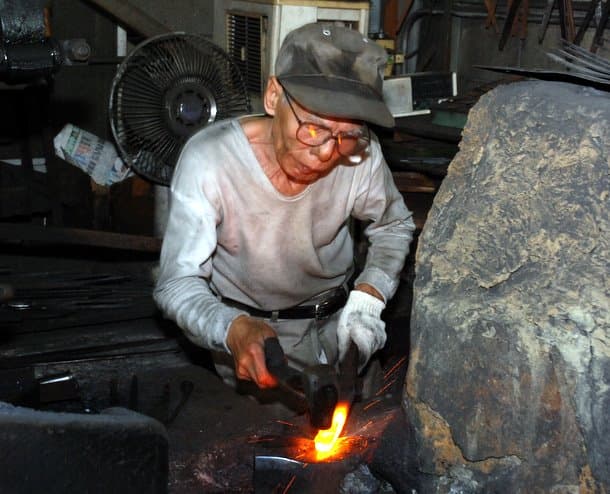
japanese chefs knives
Explore the world of Japanese kitchen knives, their styles, and techniques in this article. Visit Korin Trading for the most extensive collection of top Japanese knives and expert advice on choosing the right one. Learn about traditional knife commitment, the relationship with your knives, and sharpening techniques for a deeper appreciation of Japanese cooking.
Please check out my story in Salon.com about Japanese kitchen knives!
So how do you figure out which is the right knife for you?
When I visited Osaka's giant Ichimonji knife company not too long ago -- which displays a mind-boggling thousand blades -- I watched the salesmen quiz customers on everything from hand size to kitchen size, leafing through thick knife catalogs packed with price, size, steel and handle specs. But ultimately it's about feel. Customers tried one knife after the other and pretended they were cutting -- like playing the kitchen version of air guitar -- until they found the blade that did it for them.
Which style should you buy, Western or traditional?
Top quality Western-style knives from Japan have the sharpest, most precise blades you can find in this category (German and French knives don't compare). They're produced from high-tech stainless steel, so they won't rust. And you work with them the way you'd work with any serious chef's knife. Handcrafted traditional Japanese knives, on the other hand, require a bigger commitment. Carbon steel rusts unless you maintain it. And you have to learn different cutting techniques, too -- I've seen books on the subject.
But as the ever gracious Mr. Shinichiro Terakubo, the 18th-generation owner of Kyoto's hallowed Aritsugu knife company, once told me: You'll gain a respect for fine traditional Japanese knives that goes beyond mere utility. To this man -- who has sold blades to the world's best chefs -- these blades carry a unique spirit. Cooks build a unique relationship with their traditional knives. Sharpening and caring for them is even "a way to get to Zen," he believes.
I've been thinking a lot about Mr. Terakubo's words after I bought my own set of traditional Japanese knives at his shop this past November. (I'm not going to tell you how much they cost. Gulp.) I've been cutting with them since at Matsuri, the restaurant kitchen where I volunteer, and it's been a remarkable experience.
Chef Ono has been teaching me knife skills (thank you, chef), and I've began to slowly (and painfully -- bloody fingers sometimes -- but as the chef likes to say, "no pain, no gain!") get a feel for my blades. The cutting technique is totally different than with Western knives. For instance, with the yanagi, the long sashimi knife, the chef taught me how to pull the blade while arcing it in a crescent-like swoop. I have to really concentrate because these tools are so precise. Canting it the wrong way even a degree or two messes up the cut. Last night Chef Ono showed me a new cut, the katsura-muki technique for cutting a continuous, paper-thin sheet of daikon. I'm going to need a few months to get that one down -- at least.
By the way, to teach yourself: The excellent Japanese Cooking, A Simple Art has useful chapters on traditional knives and cutting techniques, and Chiharu Sugai, the knife sharpening master of Korin, has produced an outstanding sharpening instructional DVD.
Working with these traditional knives and learning how to sharpen them has added a new dimension and depth to my appreciation for Japanese cooking. When I enjoyed dinner last week at Sushi Zen in Manhattan, sitting at the dining counter across from Chef Suzuki, a true master, I found myself as rapt by his cutting technique as I was by his peerless sushi. Like Mr. Terakubo said...
